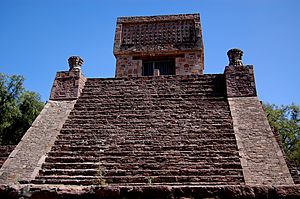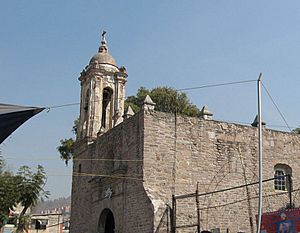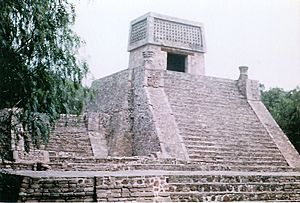Santa Cecilia Acatitlan facts for kids

The main staircase of the pyramid at Acatitlan.
|
|
| Location | Tlalnepantla de Baz |
|---|---|
| Coordinates | 19°33′09.30″N 99°10′24″W / 19.5525833°N 99.17333°W |
| History | |
| Periods | Late Postclassic |
| Cultures | Chichimeca |
Acatitlan is an amazing archaeological site from the time of the early Aztec people. Its name comes from the Nahuatl language and means "place among the reeds." The site is in the town of Santa Cecilia, just outside of Mexico City. Hundreds of years ago, before explorers arrived from Europe, Acatitlan was on the shore of the great Lake Texcoco.
History of Acatitlan
Acatitlan was a partner city to Tenayuca, which was a major political and religious center for the Chichimeca people. The two cities were only about 3 kilometers (about 1.8 miles) apart.
Later, the powerful Mexica civilization took control of Acatitlan. It became part of the culture that grew around the lakes in the Valley of Mexico, ruled by the great city of Tenochtitlan. This lasted until Spanish explorers, known as conquistadors, arrived in 1521.
After the Spanish conquest, Acatitlan's importance faded. Like many ancient structures in Mesoamerica, the pyramid was taken apart. Its stones were used to build new churches, houses, and other buildings for the Spanish colonists.
The Pyramid of Acatitlan
Today, only one main structure from the original site is left. It is a square base with a large staircase that once led to a temple at the top. It is believed this temple was dedicated to two important gods: Huitzilopochtli (the god of war and the sun) and Tlaloc (the god of rain).
Archaeologists discovered that the pyramid was built in layers. This means that new, larger pyramids were built right on top of older ones. At Acatitlan, they have found at least four different layers of construction. The inside of the pyramid is one of the best-preserved examples of this building style.
In 1962, an archaeologist named Eduardo Pareyon Moreno worked to restore the pyramid. He rebuilt the base and the temple on top. While this kind of major rebuilding is not usually done today, it created a beautiful example of a Mexica pyramid. It helps us imagine what the site looked like in its prime.
The Acatitlan Museum
Next to the pyramid is the Eusebio Dávalos Hurtado Museum of Mexica Sculpture. It opened in 1961 and is run by Mexico's National Institute of Anthropology and History (INAH).
The museum is named after Eusebio Dávalos, an archaeologist who once owned the land. He spent much of his life collecting ancient artifacts, which are now displayed in the museum. His collection includes pottery and stone objects from Acatitlan and other sites influenced by the Mexica culture.
The museum also has rooms decorated to look like a kitchen and living room from before the Mexican Revolution (1910-1920).
See also
 In Spanish: Santa Cecilia Acatitlán para niños
In Spanish: Santa Cecilia Acatitlán para niños




